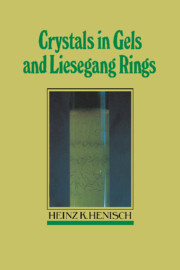3 - Growth mechanisms
Published online by Cambridge University Press: 06 January 2010
Summary
Diffusion patterns and single crystal growth rates
Gels are obviously permeable, but the fact that convection currents are suppressed, can easily be demonstrated. With an ordinary microscope it is possible to verify that particles have streaming motion in the ungelled solution but none after gelling. With a laser-ultramicroscope arrangement of the kind described by Vand et al (1966), this demonstration can be extended to smaller particles, e.g. down to about 600 Å and even below, depending on the wavelength and intensity of the laser light. Such tests do not rule out the possibility of convection currents on a submicroscopic scale, but it is implausible to believe that these play any major role.
In the absence of convection, the only mechanism available for the supply of solute to the growing crystal or a Liesegang Ring is diffusion. The complete solute diffusion pattern can evidently be very complicated, and attempts to analyze it commit us to several layers of simplification. The choices we make in this must depend, in turn, on the nature of the situation envisaged. One such situation might involve prominent Liesegang Rings, and that will be discussed in Chapter 5. Another might be represented by a small crystal, growing far from anywhere (and, in particular, far from any other crystal) in a large amount of gel. One might then consider that the solute super-saturation ϕ∞ at large (lateral) distances from the crystal remains unchanged during growth. This would be so, if the total amount of matter in the crystal were small compared with that in the gel, an assumption which is specially appropriate for the initial stages of crystal growth.
- Type
- Chapter
- Information
- Crystals in Gels and Liesegang Rings , pp. 48 - 88Publisher: Cambridge University PressPrint publication year: 1988
- 1
- Cited by

